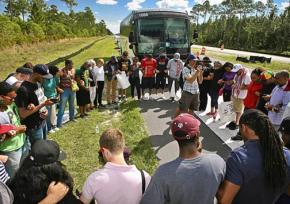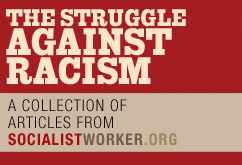On the march to Sanford
describes the journey he made with other "Dream Defenders" on a three-day march across central Florida to protest the murder of Trayvon Martin.
I DIDN'T know what to expect when I arrived in the town of Daytona Beach, Fla., on a hot and muggy Friday afternoon last week.
I knew I was joining a multiracial group of students and youth who shared the same outrage over the racist killing of Trayvon Martin, and that we would march 40 or so miles to Sanford, spread out over three days. But I didn't know what to expect along the way or once we arrived in Sanford. This past weekend would turn out to be one of the most inspiring and radicalizing experiences of my life.
After an initial meeting and prayer led by some of the march's organizers, we set out from the campus of Bethune-Cookman University, one of Florida's historically Black colleges, and began the long march to Sanford, located in the interior of the state.
Almost immediately, the feeling of solidarity and camaraderie began to develop among the marchers, who, with little else to do but walk and talk for the next three days, quickly became friends. It was truly remarkable to be treading through the brutal heat along the side of a winding Florida state highway with such a diverse group of people.

Considering the heavily drawn color line in the South that consigns communities to segregated existences, this was one of the longest times that many of us had ever spent in a thoroughly integrated setting, both Black and white. And the group was truly representative of our generation: Black and white, Latino, Asian and even Palestinian. It was also remarkable how far many people had travelled to take part in the march--from Amsterdam and Los Angeles, Chicago and New York City.
We trudged down isolated stretches of highway, with only the beating sun and swaying pine forests as the witnesses to our trek. We marched through sleepy little Southern towns, chanting and singing all the way down Main Street, with curious bystanders and eager supporters coming out of little shops and onto front porches to wave and cheer us on. Members of Occupy Daytona Beach and Occupy DeLand--who knew that the Occupy movement had invaded even such remote little places?--came out to march with us on different legs of the trip.
We also marched past silent onlookers, with their hardened faces betraying unspoken hostility. Men drove past us in pickup trucks, waving confederate flags or yelling "nigger" and "white power" through their open windows, with voices full of hate. While the majority of the reactions we received were positive, the others were enough to dispel any notion someone might have of the U.S. as a "post-racial" society.
But there were also the Black families who passed us--and turned around and pulled over to take pictures with us and thank us for marching through. Honking cars rolled by, with an outstretched Black arm clenched into a fist of support.
THE LONG conversations along the route were full of politics, ranging from whether we could start a new civil rights movement in the U.S. to the struggle for Palestine. We talked about the history of racism in the South, the civil rights movement, the history of racist police killings, stories from movements and campaigns past. All of us knew that we were battling something far bigger than just the case of Trayvon Martin.
We slept each night in beautiful African Methodist Episcopalian churches along our route, full of warm, welcoming and generous members of the congregation who fed us heartily and gave us tubs of hot water and salt for our tortured feet. Every church was nestled in the middle of the local Black community, amid empty and rundown homes, shuttered businesses and huddled groups of men out of work, a grim reminder of the brutal impact of the economic recession and the longstanding effects of racism in our society.
On the third day of the march, thirsty for more cold water and rest for our blistered and sore feet, we called a break within sight of an isolated gas station on a deserted stretch of highway. As the first of us made it through the front door of the store, the terrified owner saw our mostly Black crew and came running. He slammed the door behind us and insisted that only three people be allowed inside at a time, suspicious that we would ransack his store.
One of the march organizers, who was part of the group inside, insisted that he let the rest of us in, because we weren't going to steal anything. But the owner would have none of it. We marched out, deciding we didn't need to buy any water or snacks from a bigoted storeowner.
The marchers milled about in front of the store, simmering with anger and tweeting about the experience to news agencies covering our story, as the storeowner locked the front doors and posted his "Closed" sign in the window. Some minutes later, after realizing his store would appear on the evening news for refusing to serve a group of mostly Black college students, the owner came out and offered an absurd excuse and apology, in an effort to gain the business of the marchers. But we didn't accept and proceeded on again, with fresh determination and anger brewing in our stomachs.
One of the interesting things about the march was how it represented the new generation's use of social media, but also how it reached into the past for useful practices from movements that came before us.
The organizers were constantly asking marchers to tweet and update their Facebook pages along the route, to gain a larger following. Indeed, with major media outlets following our tweets, it proved to be a useful tactic to gain publicity. Many of the people in attendance heard about the march through Facebook and other means on the Internet.
However, the relatively small size of our contingent--25 to 40 were there for the entirety of the march--bespoke the weaknesses of pure social media "organizing," because good old-fashioned outreach through phone calls and conversations might have brought out a larger number.
As well, before the march started, one of the organizers told the assembled group that this wasn't "our grandparents' movement" and that we shouldn't carry picket signs or banners and we shouldn't chant or sing "old negro spirituals." As it turned out, these prohibitions were abandoned almost immediately. Marchers quickly started chanting and rewriting old movement songs with new lyrics to speak to the Trayvon Martin case. And we acquired a "We Are Trayvon Martin" banner and picket signs to carry.
There's something powerful about people's voices raised together in song or chants--it symbolizes the unity of the marchers, sets the pace for marching and revives people's energy and spirits when they feel exhausted and begin to dwell on the pain in their feet. One of the best songs was set to the tune of "As The Saints Go Marching In":
When Zimmerman
Gets arrested,
Oh, when Zimmerman gets arrested,
Oh, how I long to be on that jury,
When Zimmerman gets arrested.
WE FINALLY reached Sanford, marching through the hottest day of the weekend and making the streets ring with our chants and songs. News had reached us the day before that an armed neo-Nazi group was patrolling the streets of the city to "protect the white citizenry from race riots," and many people were tense about what we would face.
The media were waiting for us downtown, filming our procession as we reached deep down inside ourselves for the energy to shout, chant and sing our loudest yet. After speeches and more bluffing on the part of Sanford's city manager, we boarded a bus that would take us to the scene of the crime--the spot where Trayvon was gunned down unarmed, supposedly after "threatening" George Zimmerman.
None of us were ready for what we were about to see. The bus let us off in front of an elementary school, where, across the street, the town's only "memorial" to Trayvon Martin stood. It consisted of a school zone traffic sign, surrounded by a pile of stuffed animals, carnations, cans of tea, bags of Skittles, handwritten letters parched by the sun and pictures of a young man cut down in the flower of his youth.
The marchers held hands around the memorial, some no doubt wondering how this could be all that was left to honor a young man who was living and breathing, while his killer walks free. Many of us lost control of our emotions and let our tears run freely, standing around what really was a monument to the hypocrisy of America.
Our bus let us off again in the middle of the Goldsboro community in Sanford, a Black neighborhood which sheltered the church where we would stay. We lined up in threes, locked arms and marched as best we could down the street to the church, singing with voices now full of pain and sadness.
The entire neighborhood came out by the hundreds, waving, cheering and singing along with us, falling into our lines and linking arms with us as we hobbled toward the church. It was an incredible thing to be treated to a hero's welcome by a community that had gone through so much in this past month or so. Many from the neighborhood attended the mass meeting that night in the church and pledged to join us the next day in our planned civil disobedience.
The next morning, we left the church and solemnly marched through Goldsboro again, winding our way through a community devastated by poverty and unemployment to the front steps of the bright- and shining-new, expensive and enormous police station in the middle of the neighborhood--the perfect emblem of what Michelle Alexander refers to as the "new Jim Crow."
A group of volunteers from among our number donned hoodies and kneeled down on the front steps of the station, blocking the entrance and effectively shutting down the building. Fearful of attracting further media scrutiny, the police locked the doors and refused to arrest anyone, allowing their public operation to be closed for the day.
At the end of the day, the marchers would have to part ways to head back to their respective cities and homes. It was with heavy hearts that we bid each other goodbye, exchanging numbers and e-mail addresses and arranging a time for us all to discuss the march and make future plans. All of us committed to moving forward with the fight to win justice for Trayvon's family.
Before we all said goodbye, I had the thought that the best memorial we could ever construct for Trayvon--and all of the other Trayvons in the world--would be to build another mighty movement for equality, with so much power and clout that we could win justice in every case of racist violence and police brutality, one that could ultimately destroy the pernicious inequality and racism in our society and make one anew.
Certainly the people who marched those hard 40 miles are made of the right stuff. Now we just need to get started.



